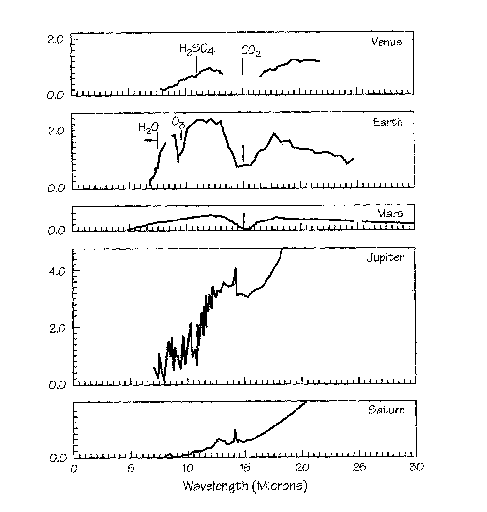Searching for Habital Extrasolar Planets Using a Large Space-Based Telescope
Using a large (10 meter) space-based telescope, spectra of either the reflected light or thermal emission could reveal the presence of oxygen. Molecular oxygen is found at a wavelength of 0.76 microns in the optical region and ozone is found at 10 microns in the infrared. The main problem with working in the optical region is the long integration times (up to several days) required to obtain a useful absorption spectrum. The accuracy of the mirror surface required for the telescopic search would greatly exceed the accuracy of the Hubble Space Telescope. The problems of working in the infrared are the large size of the mirror, and the need to operate at very cold temperatures (about 80 K). However, if these problems could be accommodated, the accuracy requirements for the mirror surface in the infrared are not nearly as severe as in the optical. Furthermore, the shorter integration times required in the infrared would allow high signal-to-noise spectra to be obtained.

Spectra of three terrestial planets and two gas giants
Because oxygen is produced from carbon dioxide by living organisms in the process of photosynthesis, spectroscopic analysis of extrasolar planetary atmospheres can determine whether such organisms exist. Strong and broad absorption features of molecular species allow their detection in the noisy spectra of faint objects. Methane is good example, showing a strong pattern of absorption in the reflected light from Titan and the Jovian planets. A low-resolution spectrum with a signal-to-noise of about 10:1 would be adequate for a clear detection. Oxygen is present in two molecular forms in the atmosphere of the Earth, molecular oxygen (O2) and ozone (O3). Each has characteristic absorption features due to electronic transitions at short wavelengths. The most prominent O2 absorption feature has a width of about 8 nanometers and is located around 0.76 microns. Ozone is much less abundant then diatomic oxygen, and causes complete absorption below 0.3 microns. However, ozone may be more difficult to detect than O2 since the sun's radiation is very weak at this wavelength, and most candidate stars are even weaker. At the 0.76 micron feature of O2 at least a 1.5 meter space-based telescope would be required for detection and at the 10 micron feature of O3, at least a 20 meter telescope would be needed. For an earthlike planet at a distance of 4 pc from the earth, the flux of photons received would amount to only 1 per minute by the 1.5m mirror in the O2 band. The flux would be about 300 per second by the 20m mirror in the O3 band.
The above data thus favors the large infrared space telescope over the smaller optical telescope, since it would yield planetary spectra of high signal-to-noise. It would also serve as a powerful tool for both infrared and optical astronomy. However, it would require assembly in orbit by an astronaut crew, and must rely on good thermal design and shielding to permit operation at cool temperatures (80 K). The technical problems of producing the extremely accurate optics needed to contain the very bright star image, and to build up very weak signals by very long integration times make the optical telescope option less desirable.

A 10 Meter class telescope--the Keck on Mauna Kea, Hawaii
In conclusion, the technology required to conduct spectroscopic observations on extrasolar planets will be available within the next 5 years. Astronomers and Space Scientists can look forward to searching nearby extrasolar planets for oxygen and ozone, as well as other life-bearing indicators. For now, it would be valuable to compute models of atmospheric spectra corresponding to different scenarios for the evolution of life. In turn, these could be used to help determine the best observing strategy for discriminating between planets with and without life.
Mark Elowitz




